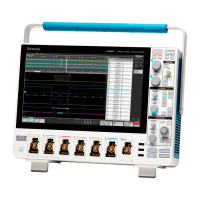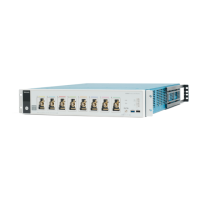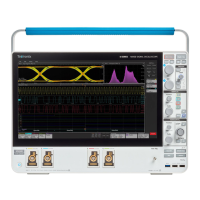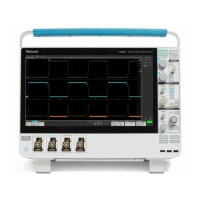Setting waveform display parameters
Use waveform display controls to set the display mode, persistence, style, and intensity display parameters, and graticule style and
intensity.
Set waveform display mode (Stacked or Overlay)
Use this procedure to change the waveform display mode (Stacked or Overlay).
1. Double-tap on an open graticule area to open the Waveform View configuration menu.
2. Tap the Display Mode buttons to toggle between Overlay and Stacked modes.
In stacked display mode, each waveform is stacked vertically in separate graticule slices. This is the default display mode.
In overlay display mode, all waveforms are displayed in a single graticule (traditional waveform view).
Set the Waveform Interpolation mode
Use this procedure to set the waveform interpolation mode, which sets how waveform data points are calculated between record data
points.
1. Double-tap on an open graticule area to open the Waveform View configuration menu.
2. Tap the buttons under Interpolation to select either Sin(x)/x or Linear.
Sin(x)/x calculates record points along a curve between the actual acquired samples. This form of interpolation is useful when
acquiring rounded waveforms such as sine waves. It is good for general-purpose uses but may introduce overshoot or undershoot
in signals with fast rise times. This interpolation is also useful for looking at high-frequency signals, especially where the frequency
components are just below the Nyquist frequency.
Linear calculates record points between actual acquired samples using a straight-line fit. This interpolation is useful for measuring
waveforms with fast rise times, such as pulse trains.
Set the waveform persistence, style, and intensity
Use the Waveform View configuration menu to set waveform persistence, style, and intensity.
1. Double-tap on an open graticule area to open the Waveform View menu.
2. Tap the Persistence field to select the persistence option.
a. Off disables display persistence.
b. Auto lets the oscilloscope automatically determine a persistence time for you.
c. Infinite persistence continuously accumulates record points until you change one of the acquisition display settings. Use infinite
persistence for displaying unique signal anomalies, such as glitches.
d. Variable persistence accumulates record points for a specified time interval. Each record point decays independently according to
the time interval. Use variable persistence for displaying infrequently appearing signal anomalies, such as glitches.
If you select Variable persistence, tap Variable Persistence Time and set the time using the multipurpose knob, or double-tap the
field and use the virtual keypad to enter the time value.
3. Tap the Waveform Style buttons to set waveforms to draw as vectors (continuous lines) or dots.
• Vectors displays the waveform with the waveform sample values connected using the selected interpolation method.
• Dots displays the individual waveform sample values with no interpolation.
Setting waveform display parameters
2 Series MSO MSO24 and MSO22 87
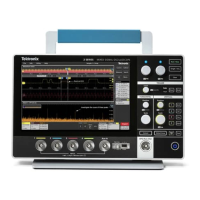
